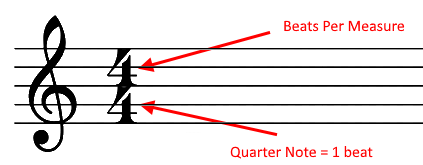Strumming
Strumming is the act of hitting all the strings in a chord at once to form a full chord sound.
By contrast, playing each individual note of a chord, one at a time, is an arpeggio.
In the Open Chord tutorial, I strummed a chord, then arpeggiated it up and down, then strummed again.
We'll talk more about arpeggios in another lesson.
Notes and Timing Recap
Everything in music is based on note duration.
For this tutorial, we're concentrating on 4/4 Common Time

The top number tells you the number of beats per measure.
The bottom number tells you what note gets one beat, in this case, the quarter note.
The speed of a song is called the TEMPO of the song.
All of the sound examples on this site are at 120 beats per minute.
The following shows one measure and the number of each notes that fill the measure
Since the Quarter Note gets 1 beat, and there are 4 Quarter Notes in a Whole Note, the Whole Note gets 4 beats.
One Whole Note fills the measure in 4/4 Time.

The Half Note gets 2 beats. 2 Half notes fill the measure.

The Quarter Note gets 1 beat. 4 Quarter notes fill the measure.

The Eighth Note get 1/2 beat. 8 Eighth notes fill the measure.

Strumming Patterns:
Whole Note Pattern
The first, and simplest is the Whole Note.
You simply strum the chord once, on the 1st beat, and let it ring through the whole measure.

Most of the time you strum these with a down stroke, towards the floor. But, there is no rule that says you have to.
Here is an example of the Whole Note Strummed.
Half Note Pattern
You strum the chord on the 1st beat and 3rd beats of the measure.

Once again, this shows all downstrokes.
Here is an example of the Half Note Pattern Strummed.
Quarter Note Pattern
You strum the chord on all beats of the measure.

Once again, this shows all downstrokes.
Here is an example of the Quarter Note Pattern Strummed.
Eighth Note Pattern
This is our first pattern with upstrokes. You strum down on the beat, and up on the half beat.
The way Eighth Notes are counted is ONE-and-TWO-and-THREE-and-FOUR-and. Don't forget the last "and".

Here is an example of the Eighth Note Pattern Strummed.
Down Down Up Up Down Pattern
The Down Down Up Up Down Pattern is the pattern that may give you trouble at first,
but it is the pattern that opens up the world of strumming to most people.
It's also a pattern that tells you how to strum it, in it's name.
You strum down on the 1st, 2nd and 4th beats, and up strokes on the 3rd beat and the 3rd beat's AND.
It's a very common strum pattern that is in a lot of well known songs.
Here is an example of the DDUUD Strum Pattern:
Wrap Up
In this lesson, we concentrated on strumming. This is not all the strumming patterns!!!
You can mix a Half Note for the first 2 beats, and have eighth notes for the last 2 beats.
There are many more, and you can make up new ones yourself.
There is no rule in music that says you have to strum something, or arpeggiate something.
You could strum one measure, and arpeggiate the next.
If you're playing with someone else, one can play chords, while the other arpeggiates the chords.
There are no rules.